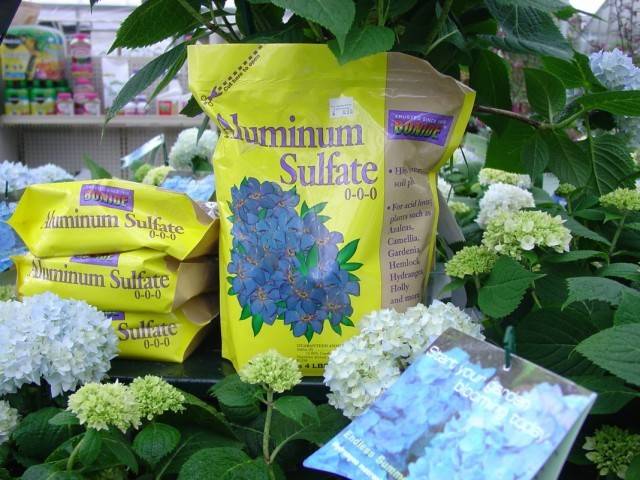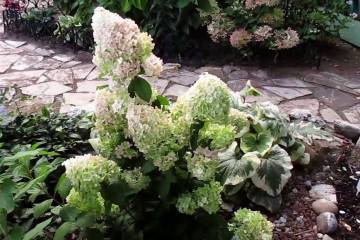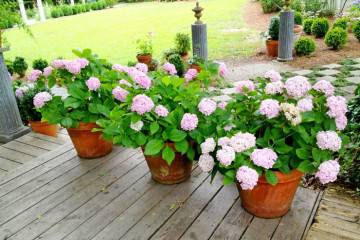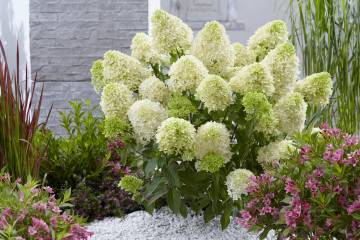Hydrangea Macrophylla (Hydrangea Macrophylla) - description
Content:
Unique spherical inflorescences on the bushes of hydrangea or hydrangea Macrophylla can be increasingly found in the gardens of our country. The unusual color and luxurious silhouettes attract gardeners, despite the difficult nature of the plant. This "hydranga queen" is great for landscaping and indoor potted growing, but needs careful maintenance and is very demanding on growing conditions.
Hydrangea large-leaved Macrophila: description and origin
Hydrangea Macrophylla belongs to the genus Hydrangea, the Hydrangea family. China and the Japanese Islands are considered the homeland of hydrangea, and Hydrangea Macrophylla seedlings were brought to European territory almost two hundred years ago. Since then, breeders have bred over a hundred more hybrids. Most of all new varieties are bred in France, for example, one of the most beautiful and original - Miss Saori hydrangea with flowers that resemble a spiky ball of a very original color.
The height of the Macrophylla hydrangea bush can reach one and a half meters (limited by cold climatic conditions). The leaves are large, bright green and shaped like an egg. Broadly spreading shoots extend straight from the trunk.
Lush inflorescences are collected in balls of 20 cm in diameter. The color palette ranges from lilac to blue and even pink.
How the Macrophylla hydrangea blooms
Hydrangea Macrophila blooms in early summer. Flowering (depending on the variety) continues until mid-autumn. In the buds, the petals are white with a slight light green tint. As they bloom, they turn blue, pink, lilac, purple, or simply snow-white.
The acidity of the soil has a great influence on the color palette of inflorescences:
- neutral acidity gives a white or creamy shade;
- alkaline soil makes flowers lilac or pinkish;
- acidic soil promotes the appearance of blue and purple "balls".
Growing hydrangeas outdoors
According to the description of Macrophila hydrangea, the key to its lush and long flowering is the correct determination of the planting site and strict adherence to agrotechnical rules. Manipulations should be done very carefully and carefully. It is important to adhere to suitable dates for planting a flower in open ground (especially for central Russia with its harsh winters). This should be done in the spring, as soon as the soil has completely thawed and warmed up enough in the spring sun. At this time, return frosts are no longer found. The planting of bushes is carried out observing a distance of one meter between them.
What is needed for landing
For hydrangea cultivation to be successful, you need to prepare optimal soil for it. It should have the following composition:
- humus;
- sod land;
- rotted leaves;
- peat mixture or sawdust of coniferous trees;
- fine sand;
- special feed additives for hydrangea (available in garden stores).
The constituent parts of the soil are taken in equal parts.
Choosing the best place
Despite the fact that hydrangeas are considered shade-tolerant plants, this does not apply to this variety. Even in the southern latitudes, Macrophyll bushes grow at a maximum in partial shade, and in the harsh Russian climate they are considered to be sunshine lovers. However, planting it in too open flower beds is also not worth it.
It is also necessary to take into account the proximity of other shrubs and trees (buildings). Hydrangea Macrophylla belongs to moisture-loving plants, so it may not have enough water in the ground due to such large neighbors.
Step-by-step planting process
For the shrub hydrangea rough Macrophylla, planting and care is carried out according to the following algorithm:
- The purchased flower is taken out of the pot and soaked in a container of water for 2-3 hours. The roots must be divided, but it is better not to remove the soil from them for better adaptation of the bush to a new place.
- Dig a hole in the selected place and, 24 hours before planting the bush, fill it with water at the rate of two buckets of water per hole.
- The wells are filled with a soil mixture with the addition of potassium-phosphorus fertilizers.
- The young plant is placed in the hole. The roots of the flower should be carefully spread out for better rooting.
- The root zone is covered with earth and slightly compacted.
- A freshly planted bush is watered abundantly, the soil around it is mulched with straw or dry peat.
Reproduction of Macrophyll hydrangea
This type of hydrangea is propagated by cuttings, layering and dividing the bush.
Propagation by cuttings
Cuttings are cut in early spring from a perennial bush. There should be one internode on the cut stem. The upper cut is made at a right angle, and the lower one is made at a sharp angle; half of each leaf is also cut off. Next, the cutting is half buried in moistened soil and covered with plastic wrap, which is removed after rooting.
Reproduction by layering
To obtain layering, the shoots of one-year-old hydrangea are tilted to the ground and sprinkled with earth, leaving only the top 20-25 cm long on the soil surface. Layers should be watered every three days, and after rooting, they are cut off from the parent bush and planted in separate holes.
Dividing the bush
An overgrown bush of large-leaved hydrangea can be divided. To do this, the rhizome should be freed from a clod of earth and cut off the old stems. The bush is divided into several parts. Their roots should be trimmed and the divisions should be immediately planted in the places allotted to them. Then water the soil abundantly.
Macrophylla Hydrangea Care
For the flower of Hydrangea Macrophylla, care at home and in the open field consists of proper watering, feeding, protection from diseases and frost.
Watering mode
Hydrangea Macrophylla loves moisture, it's not for nothing that the plant is also called hydrangea. Therefore, watering should be carried out at least once every couple of days, the minimum volume of water is 1-2 buckets per bush. The water is suitable settled and purified, soft or acidified (for blue and lilac species). In the heat, more water is needed.
Top dressing
Hydrangeas need intensive feeding with organic matter (liquefied manure, chicken droppings) and balanced mineral complexes. There are fertilizers on sale specifically for this type of plants (mainly phosphorus). The frequency of feeding the flower is a couple of times a month.
Features of care during flowering
For Hydrangea Macrophylla, when grooming at home, it is important to consider the desired flower color. Which component to choose fertilizer with depends on the desired color of the hydrangea "balls". For example, special fertilizers containing aluminum give a pink color.
During the period of ejection of buds, it is necessary to supply the plant with a large amount of trace elements. You should also cut off the basal side shoots, leaving the strongest ones.
Features of care during the rest period
After flowering, it is necessary to cut off all the dried parts of the bush and thin out its center. Last year's stems are reserved for future flowering.
Preparing for winter
This type of hydrangea is characterized by average winter hardiness. So that the flower does not suffer from frost, it must be cleaned of dry leaves, the branches are tied in bunches, tilted and pressed to the ground. Wrap these "piles" with non-woven fabric and cover with foliage.
The unique spherical flowers of the large-leaved bush hydrangea have many fans among gardeners. Taking care of the plant is quite difficult, but the beautiful lush bloom will be a worthy reward for your efforts.





















